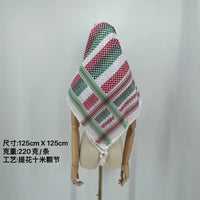The Keffiyeh, Shemagh, and Ghutra: More Than Just Scarves
Lately, you might have noticed the keffiyeh making a fashion comeback. This scarf, with roots deep in the Arab world, has traveled far and wide, thanks to diasporas. Across the Arab region, you'll find various types and styles of the keffiyeh, each with its own unique meaning and often multiple names. Today, let's get to know the three most popular styles: the keffiyeh, the shemagh, and the ghutra.
Meet the Keffiyeh

Think of the keffiyeh as the all-encompassing name for these scarves. Made from pure cotton, these square scarves, measuring about 3.3 feet (or one meter), were traditionally worn by men. But now, both men and women are embracing this stylish accessory. While some factories use a blend of polyester and cotton, the most authentic ones come from the Arab world, like the Hirbawi factory in Hebron, which sticks to pure cotton.
Traditionally, the keffiyeh is folded into a triangle, placed on the head, and secured with a thick cord that looks almost like a rope. Some folks also like to wear it as a scarf around their neck, but that's not the traditional way.
The keffiyeh's history dates back thousands of years to Mesopotamia. It's believed that Sumerian and Babylonian priests wore it as a status symbol. But over time, it became more practical, with the working class using it to shield themselves from the hot sun and blowing sand.
Later on, the keffiyeh became a symbol of Palestine and resistance, particularly the white-and-black checkered one. During the 1936 Arab Revolt under the British Mandate of Palestine, protesters wore it to hide their identities from the British. When the British banned it, everyone started wearing it, making it a symbol of collective resistance for Palestinians.
Today, the keffiyeh is the most recognized and worn scarf. Many non-Arabs wear it as a political statement or to show support, which gets mixed reactions from Palestinians and Arabs.
Say Hello to the Shemagh

Next up, we have the shemagh, a red-and-white checkered scarf with tassels. The size of the tassels indicates the person's importance. It's closely associated with Jordan and isn't as politicized as the keffiyeh. Still, it's a proud national symbol of Jordan.
Get to Know the Ghutra

Last but not least, there's the ghutra. Unlike the keffiyeh and shemagh, the ghutra is completely white and made from a slightly thinner cloth. It's most popular in the Gulf, especially in Saudi Arabia. The ghutra is also folded into a triangle, worn on the head, and secured with a thick black cord called the igal.





